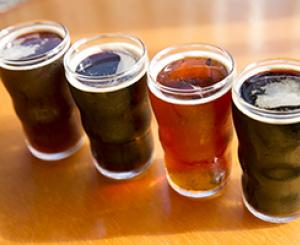
For all the progress craft beer has made in the past few decades—reaching an all-time high brewery count and successfully reinventing America’s beer palate—there’s still a large portion of the population that doesn’t get craft beer. To reach the Brewers Association’s aspirational goal of helping craft beer reach 20 percent market share by 2020, as craft beer fans, we’re going to have to be even bigger and louder advocates for our favorite breweries.
I asked several brewers what they felt were common reasons why people don’t try or like craft beer. Their answers were amazingly consistent, and they offered up some good strategies to help open new drinkers up to craft beer.
Make it one of your New Year’s resolutions to win over your family and friends to craft beer with these helpful tips.
1. Over Geeking It
The rise of craft beer is sometimes described as the “winification” of beer. That’s easy to understand with talk of sniffing, swirling and mouthfeel. And while advancing appreciation of taste is a logical path for an experienced craft beer drinker, our experts advise that it is not a good way to win over a new craft drinker.
“It seems the main reason for people not trying craft beer is because of the way it’s introduced to them,” said Michael Lyn Bryant, General Manager & Creative Director at Dunedin Brewery in Tampa, Fla.–the oldest craft brewery in the state. “If the introduction comes off as pretentious, that could turn someone off.”
Roxane Nielsen, co-owner at Prescott Brewing Co. in Prescott, Ariz. and a 21-year veteran in craft beer, advocates the KISS approach to matching someone to a craft beer. She maintains that KISS—Keep It Simple Stupid—is essential to pairing a new drinker with the right beer.
“Don’t overcomplicate it—don’t act like a beer snob,” she cautions. “A large selection of unfamiliar names and styles can be intimidating.” She advocates new craft beer drinkers taste samples to narrow down the discussion and to best pair the beers the customer will like best. She notes that tasting also empowers a person to be happy with their selection.
Steve Jones at Pateros Creek Brewing Co. in Ft. Collins, Colo. also advises keeping the craft beer experience down to earth.
“We can geek out all we want to amongst ourselves. But it’s my opinion that we are going to brew ourselves out of existence if we don’t keep the average beer drinker happy.”
Bryant said it is important to speak to new craft beer drinkers in language that they can relate to.
“If they don’t have a strong beer vocabulary, it’s important to talk to people in their terms,” explained Bryant. “Maybe they like chocolate, caramel or tropical fruit. These are the doorways that help people identify with new ideas and experiences.”
2. Starting with Your Favorite IPA
It may be the most popular craft beer style in America, but can we all agree that extremely hop-forward beer is an acquired taste? Our experts counsel that it’s not a good first choice for new craft beer drinkers.
“The most common misunderstanding about craft is that not all beer styles are heavily hopped,” said Carole Kennelly, Brand Warrior at Historic Brewing Co. in Flagstaff, Ariz. “It has been my experience that if someone says they do not like craft, what they are actually saying is they do not like IPAs.”
She said it’s vital to educate new customers that many craft beer styles do not have a hop heavy taste profile.
“It is a daily occurrence that a self-proclaimed non-beer drinker will get turned on with one sip of our Cherry, Vanilla Piehole Porter,” she noted. Ultimately, she reminds, there is something for everyone in the countless world of craft beer styles.
Nielsen seconds her Arizona colleague in cautioning about IPAs, which she termed a “curse” for new drinkers (and they make good IPA, folks!).
“A previous bad experience with an IPA that someone was not prepared for can lead to a bad connotation of craft beer as a whole,” said Nielsen.
3. Forgetting to Share the Powerful Story of Craft Beer
Probably no one in craft beer knows the power of the big beer brand like Schlafly Beer’s Co-Founder Dan Kopman, in St. Louis, Mo. the longtime home to Budweiser.
“We’ve been around for 24 years, and we’ve built a haven for loyal domestic drinkers to find something different they haven’t seen in the grocery store aisles,” Kopman said.
He said they converted big beer drinkers at their two locations one person at a time through tasting and a lot of patience.
“It’s not enough to make great craft beer,” said Kopman. “You have to welcome people into your taproom or restaurant and be a guide, but without being preachy.”
Both Kennelly and Nielsen said that all the money big beer has spent over the decades to create brand loyalty has created a barrier, but also an opportunity.
The two brewers say the power of craft lies in promoting the individuality and story of the neighborhood craft brewery to new drinkers. Better beer, is, after all, a strong and local selling proposition.
“Craft drinkers tend to identify themselves as being different from the standard,” said Kennelly. “They drink craft because it says that they are open to new experiences, more adventurous or simply it says they believe in quality.”
To remedy your biggest mistakes when introducing someone to craft beer, please visit Craftbeer.com.
